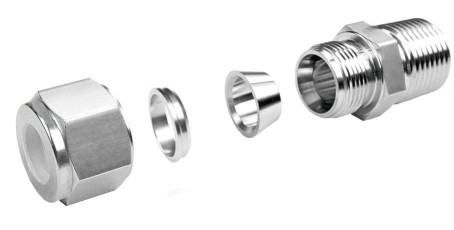The landscape of fluid systems is dynamic. Power transmission must be reliable and efficient. Engineering boundaries are pushed in this quest. High-pressure compression unions are explored in this exploration. The mechanics, advantages, and diverse applications of these unions are showcased. They play a pivotal role in navigating extreme pressures seamlessly.
Join us as we explore the complexities and benefits of these connectors. They are essential for pushing power transmission limits.
What is a Compression Union Used For?
In the intricate world of fluid systems, a compression union plays a pivotal role. It acts as a connector, joining two pipes or tubes securely. This device is unassuming but crucial for many applications. It helps with fluid flow and power transmission in high-pressure environments.
Mechanics Behind High-Pressure Connections
How Compression Unions Work
Compression unions operate on a simple principle in high-pressure systems. They are ingenious. These unions use compression to create a tight seal around pipes. They typically use a ferrule or sleeve to do this. Mechanical compression guarantees a tight connection. It is crucial for precise applications.
Importance of Precision in High-Pressure Environments
In the realm of high-pressure, precision becomes the cornerstone. Any change in how the union is compressed or aligned can cause problems. These problems can include inefficiencies or even system failures. The mechanics require precise engineering. It must withstand strong forces in tough conditions.
What is the Maximum Pressure for Compression Fittings?
Understanding the limitations of compression fittings is paramount. These fittings can handle different amounts of pressure. The amount depends on factors like materials, design, and application. It is crucial to follow the suggested pressure limits. This will guarantee the system’s durability and reliability.
Types of High-Pressure Compression Unions
➡️ Ferrule Compression Unions
Ferrule compression unions use a tapered, conical ring to create a seal. The ring compresses for sealing. This design is reliable and easy to use. It is popular in high-pressure systems. It provides a secure connection.
➡️ Sleeve Compression Unions
Sleeve compression unions employ a cylindrical sleeve for compression. This design is favored for its versatility and suitability for diverse materials. Sleeve unions excel in providing a robust connection in demanding environments.
➡️ Double Ferrule Compression Unions
Double ferrule compression unions elevate the game by incorporating two ferrules. The design improves the pipe’s grip for a secure connection. It also prevents leaks. The double ferrule design is often preferred in critical applications.
Advantages of High-Pressure Compression Unions
➡️ Seamless Power Transmission
The primary advantage lies in the seamless transmission of power. High-pressure compression unions ensure an uninterrupted flow. This is vital for industries where downtime is not an option.
➡️ Durability and Reliability
In the face of extreme pressures, durability is non-negotiable. The unions are built to last. They can withstand tough conditions. They are reliable.
➡️ Versatility in Challenging Environments
High-pressure compression unions exhibit remarkable versatility, thriving in environments where challenges abound. From corrosive substances to fluctuating temperatures, these unions adapt and deliver consistently.
Check out these other resources ⬇️⬇️⬇️:
Snap, Lock, Connect: Navigating The Types Of Camlock Fittings
Understanding The Role Of Hydraulic Hose Adapters In Fluid Systems
Male And Female Hydraulic Fittings: Unveiling The Essential Distinctions
Choosing the Right High-Pressure Compression Union
Factors to Consider
➡️ Material Compatibility
The material of the compression union must align with the fluids it will handle. Compatibility is crucial to prevent corrosion or degradation over time.
➡️ Size and Configuration Options
Choosing the correct size and setup ensures a perfect fit. This reduces the chance of leaks and improves system efficiency.
➡️ Application-Specific Requirements
Understanding the unique demands of the application is paramount. Tailoring the compression union to specific requirements is key. This applies whether it’s in the energy sector, manufacturing, or aerospace.
Installation and Maintenance
➡️ Proper Installation Techniques
Installing high-pressure compression unions demands adherence to best practices. Precision in assembly and torque application ensures a leak-free connection.
➡️ Routine Maintenance for Optimal Performance
Regular maintenance is the unsung hero of longevity. Periodic checks, inspections, and replacements contribute to optimal compression union performance. These checks should be done periodically and when necessary for optimal performance.
Safety Guidelines for High-Pressure Connections
➡️ Importance of Following Safety Protocols
In high-pressure systems, safety is non-negotiable. It is crucial to follow safety protocols when installing, maintaining, and operating equipment. This is necessary to prevent accidents and keep personnel safe.
➡️ Ensuring Leak-Free Connections
Leak-free connections are a testament to the effectiveness of compression unions. These connections go beyond safety and can withstand high pressure. Rigorous testing ensures that connections hold under stringent conditions. Quality assurance protocols are in place for this purpose.
Global Impact: High-Pressure Connections in Various Industries
➡️ Energy Sector
High-pressure compression unions are essential in the energy sector. They ensure efficiency and reliability in fluid transmission. These unions play a pivotal role in extracting and transporting energy resources.
➡️ Manufacturing and Processing
Manufacturing processes rely on precision and efficiency. High-pressure connections allow for smooth fluid management. This helps ensure the reliability and productivity of manufacturing operations.
➡️ Aerospace and Defense
High-pressure compression unions are crucial in aerospace and defense applications. They ensure the reliability of fluid systems, which is important for precision. These unions also help maintain the safety and functionality of critical components.
Troubleshooting High-Pressure Compression Systems
➡️ Identifying and Addressing Common Issues
Troubleshooting is critical for maintaining optimal performance due to various issues. These issues range from minor leaks to alignment concerns. Identifying and addressing issues promptly is key to preventing system failures.
➡️ Tips for Efficient Problem Resolution
Efficient problem resolution requires a systematic approach. Understanding the root cause is key. Implementing corrective measures ensures system longevity. A proactive stance is crucial.
Final Thought
High-pressure compression unions are intricate connectors in power transmission. These unassuming unions become evident as we delve into their world. They are evidence of the inventiveness of engineering. These connections go beyond conventional limits. They ensure power is harnessed efficiently and safely. They work in demanding environments.
Post time: Jan-12-2024


